A Year in the Garden
Posted on Thursday, March 13, 2025 · Leave a Comment
As we begin 2024, I think it is good not only to look back on the year we have just concluded, but also to plan ahead. We can’t know if we’ll be facing hot and dry or wet and soggy this summer – or perfect conditions. But we can make plans and hope for the best.

Diseased tomato leaves are often a problem in wet summers
For many of us, 2023 was a disappointment. The summer was rainy much of the time. Vegetables like tomatoes and potatoes – vegetables that require lots of energy to build fruit or tubers – did not do well. Fungal diseases like late blight are most virulent with moist conditions, which we had in spades. And in my part of the world, there was a late frost that spoiled the blossoms on uor fruit trees – so no apples or pears. Sigh.
On the other hand, it was a great summer for newly planted trees and shrubs. I planted yet another pawpaw tree this summer, along with a fringe tree , an American hazelnut and a gooseberry. Although I watered them all well at planting time, the soil stayed moist all summer from the rain, and all have done well.
Pawpaw (Asimina triloba) is a native fruit tree that is common in the woods of Pennsylvania and Ohio. The fruit is almost tropical in flavor, sometimes compared to a mix of mango and , banana flavors. The trees are rated hardy to zone 5 (minus 20 degrees F), but I have had one survive much colder temperatures – and another that died in a cold winter.
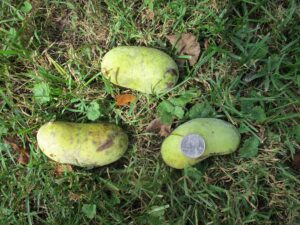
Pawpaw fruit has a tropical flavor but a texture that is mushy.
I have one pawpaw tree that is now 20 feet tall and 10 years old or more, but I am yet to get any fruit from it – despite the fact that it has blossomed. Apparently they are self-sterile, so in the past three years I have been planting new trees from different sources. Pawpaws send up root suckers, but these are genetic clones and not suitable for pollinating the mother tree. They are most often pollinated by insects that feed on dead meat, so one friend I know hangs road kill in her trees to attract pollinators!
A few thoughts about planting trees: First, preferentially choose trees and shrubs that are native to New England – or the United States. These are best for our birds and pollinators. And no, that doesn’t mean you should deprive yourself of the beauty of a Merrill or Jane magnolia. I just want to suggest a 90-10 or 80-20 ratio of natives to imported or hybridized varieties.
Secondly, if you plant trees in spring or summer, you must water during dry times. Fall is usually wet enough. A newly planted tree needs 5 gallons of water once a week distributed in a wide circle around it. A 2-inch layer of mulch will help minimize drying on hot August days and keep the mowers and string trimmers at bay. Mulch will also minimize weeds that compete for nutrients and water.
Some gardeners focus on growing vegetables, others on flowers. I want both. I started as a vegetable gardener, largely because there is little better in life than biting into a home grown tomato warm from the sun. I grow both heirloom tomatoes like Brandywine, Cherokee Purple and Ox Heart. But I also plant and hybrids like Sungold, my favorite cherry tomato, and Defiant, which is resistant to some diseases.
If you grow open pollinated (heirloom) tomatoes, you can save a few seeds each year and dry them on a paper towel. Store them in a cool dark location and they will serve you well if you want to start your own seedlings, starting indoors in early April. But don’t save hybrid seeds as most will not breed true.
One of my readers wrote me this fall reminding me of something I wrote long ago: “I will make it through another winter because I want to see what else did.” It’s true. I can’t let age catch up with me because I want to see the annual show: snowdrops blooming in March; my Merrill magnolia which blooms each year with a thousand double white blossoms on my birthday in April; and the Japanese primroses – 500 to a 1,000 of them beginning in May and lasting until mid-June.

Gomphrena, an annual, is great in arrangements.
My advice about planting flowers is simple: grow what you love. Grow what your Grammie and mother grew. Grow what stops you in your tracks when you see if for the first time each season. Plant more of your favorites each year, or divide them and spread them out to new corners of the property. But keep it simple: Don’t plant so much that weeding becomes a dreaded chore.
I love arranging flowers and keep a vase of my own cut flowers on the table from March until after Halloween. You can do this if you plant lots of bulbs for early spring, your favorite perennials, and very importantly, this: plant annual flowers. Annual flowers keep on blooming all summer if you keep them from going to seed.
It’s easy to buy six-packs of annuals in spring and plant them in your perennial beds as well as in your vegetable garden. Most like full sun or part sun/part shade. And don’t fertilize annuals in the garden – too much nitrogen promotes leafy growth but delays flowering. Potted annuals do need some fertilizer as the fertilizer in potting mix is water soluble and gets used up or washes away.
Remember, as you ponder your plans for a
garden while looking at a snowy landscape, that
gardening should be fun. As they say, “Take time to smell the roses.” Place chairs or benches in the
garden so you can stop for tea or the cold beverage of your choice while chatting with a friend or loved one. My
garden is my respite. It’s where I go when the world is too much with me. So do some planning now. Read
gardening books. And dream. I certainly do, and know it pays off . Henry’s column will appear at the beginning of each month this winter. You can reach him at
henry.homeyer@comcast.net or PO Box 364, Cornish Flat, NH 03746.
The Tomato: Queen of the Garden!
Posted on Sunday, June 4, 2023 · Leave a Comment
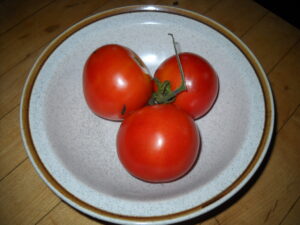
Defiant tomato are resistant to late blight
For me tomatoes are the best tasting, most important vegetable I grow. I eat them raw in salads and sandwiches or cooked in soups and stews. I dehydrate some, I freeze many whole, and I make some sauce for quick dinners in winter. But they are not grown without difficulties – and sometimes heartbreak.
Heartbreak is rare. More than 10 years ago something called “late blight” came early and infected tomatoes all over New England. Plants blackened and died, and the fruits rotted quickly, becoming inedible. Although many people blamed the Big Box stores, who knows? Spores can travel hundreds of miles in the wind.
Varieties of tomatoes have been bred to resist late blight since that fatal summer. The only one I have grown is called ‘Defiant’, developed by Johnny’s Selected Seeds. It is a nice F-1 hybrid with 4- to 6-ounce fruits that appear early. It is a determinate tomato which means that it produces a crop, then dies. Indeterminate varieties keep on producing until frost or blight kills them.
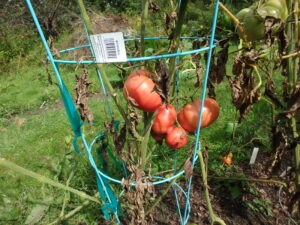
The leaves here have been killed by a blight which is common but does not affect the fruit
Of lesser portent is ‘early blight’. Except for first time gardeners, we all get it. It causes lower leaves to darken and dry up, but fruit is produced until all the leaves are gone. You can minimize this problem by mulching under your tomatoes with grass clippings or chopped fall leaves. You should do that now. Unlike late blight, early blight survives our winters in the soil, and splash up from hard rains or watering gets it onto the leaves.
Other fungal diseases are common, but can be minimized by spacing your plants well so they are not crowded. I use 24-inches spacing between plants and that seems adequate. It allows good sun sunshine on the leaves and breezes to keep the plants healthier.
To minimize diseases, don’t get the leaves of your tomatoes wet if you can avoid it. Avoid overhead watering devices, even though they are convenient. I use a watering wand to water my veggies as it allows me to direct the water just where my plants need it. It saves water, too, as I am not watering the walkways – and encouraging weeds there. The brand I like best is Dramm. Theirs allow good flow, but are gentle on the plants.

A watering wand directs a soft spray just where you want it
By now most of you have planted your tomatoes. If you haven’t, and if you think this will be a hot, dry summer, plant them deep in the soil. You can bury the root ball six inches down or more, and the stem will grow roots in the cooler, moister soil down deep.
Tomato plants need support. Forty years ago or so, when I was less experienced than I am now, I tried just putting straw on the ground and letting my tomatoes flop over and lay on the ground. I had heard it would work just fine, but it didn’t. It was harder to weed, and tomatoes were more prone to rot.
Now I use tomato cages. They are an investment, but last for 20 years or more, especially if you store them in the barn for winter. Get the biggest ones you can find. Generally that means a wire cage that has four legs (not three), and is 54-inches tall. These cages need to be pushed into the ground at least six inches so they will not tip over. If you have rocky soil, you may have to try several positions before you can install it deep enough.
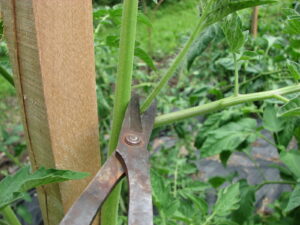
Remove tomato suckers early and often
Alternatively, you can buy 5- or 6-foot hardwood stakes. These are one inch square stakes that come with a pointed end that you can drive into the soil with a hammer – small rocks or not. But you have to tie your tomatoes to the stakes as they grow up. You can use old rags to tie them on, or sisal twine. Don’t use plastic twine as the vines may get damaged when they are loaded with heavy tomatoes. You may need to tie your tomatoes onto cages, too.
Throughout the summer you should prune out excess “suckers” that grow between the main stalk and a branch. These are just little shoots that develop into branches that clutter up the interior of your plant. They can shade out leaves and encourage diseases. If your plants get too tall in late summer, cut off the tops. This will keep the plants in their cages and putting their energy into producing fruits, not growing taller.
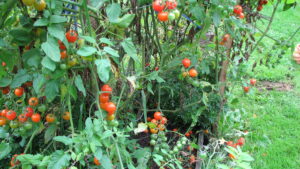
Sun Gold tomatoes
I grow at least a dozen Sun Gold cherry tomato plants each year. Each plant produces more tomatoes than I can count (even if I take off my socks to use both my fingers and toes). They are supremely tasty fresh, and are great dried and saved for soups and stews. I cut each tomato in half, and use a food dehydrator to get it ready for storage. Later, I add them to soups, stews – and even scrambled eggs.
Big tomatoes can be frozen whole and stored in Zipper bags, or chopped and stored in quart jars in the freezer. They aren’t suitable for sandwiches, but they are organic and tasty in cooked dishes.
If you freeze tomatoes whole, all you need to do is make sure they are clean. When you take them out of the freezer, you can remove the skins easily if you want by running them under hot tap water and rubbing gently.
No matter what I do with tomatoes, they always add flavor to any dish. I can’t wait for this season’s crop to be ready.
How to Minimize Tomato Blight
Posted on Wednesday, July 19, 2017 · Leave a Comment
John Denver introduced me to a Guy Clark song called, “Home Grown Tomatoes” with a refrain that goes, “Only two things money can’t buy. That’s true love and homegrown tomatoes”. How true. I love tomatoes.
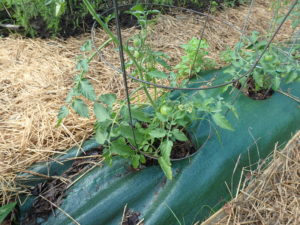
Healthy tomato plants in mid-July
Growing disease-free tomatoes is nearly impossible. Usually by this time of the year, gardeners see lower leaves turning yellow and getting spots. Stems turn black early on. Some summers, we only get a few fruits, those tomatoes that started early. Other years we get late blight half way through the season and our plants and fruit turn to disgusting black mush.
So what can we do? According to companies that produce seeds, we can choose varieties of tomatoes that are disease resistant. Breeders using old-fashioned breeding techniques have been successful in breeding resistant hybrids. But some say the flavors are not always as good as the old fashioned heirlooms. I grow both kinds.
This year I am growing ‘Brandy Boy’ (a hybrid produced by Burpee Seeds) that is supposed to taste as good as the heirloom Brandywine, one of my favorite heirloom varieties, and have improved disease resistance.
I know I like ‘Defiant’, a medium-sized hybrid with high resistance to late-blight, produced by Johnny’s Seeds. But Defiant does get early blight, which reduces its production. Still, I grow it each year.
This year my tomato plants are beautiful. Only a few leaves on a few plants showed any signs of yellowing leaves by mid-July. Here are a few things I have done to help prevent tomato diseases.
At planting time I mulched my tomatoes with leaves that I collected last fall. Some fungal disease reside in the soil, and when it rains, or when you water, splash-up sends spores onto the tomato leaves, causing disease. Mulching helps minimize splash-up. Grass cuttings are good, too.
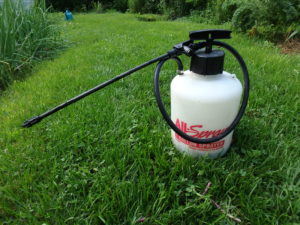
A simple one gallon sprayer is used for applying bio-fungicide
This year I got a soil drench from Gardeners Supply Company called “Root Shield”. This is a bacterial powder that I diluted with water and applied to the soil around each tomato. It is approved for use by organic gardeners. The bacteria attacks the pathogenic fungi in the soil, minimizing the chance of them getting on the tomato plants.
The other bacterial fungicide I applied is called “Serenade”, which I also obtained from Gardeners Supply Co. This contains Bacilius subtilis, a broad spectrum bio-fungicide. It is designed to be sprayed on leaves and stems once a week – and before signs of infection are seen. I have sprayed just twice, not keeping up with the schedule, but will. It’s easy to forget about disease when your plants are disease-free. Once plants are infected, both bio-fungicides are not going to solve the problem.
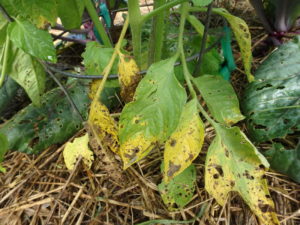
Diseased tomato leaves are often a problem
What else can you do? If you have tomato leaves turning brown, cut them off and put in the household trash, not the compost pile. I did this pretty regularly last year, and I think it helped.
If you get late blight – which basically causes a total meltdown of the plants – quickly bag everything in contractor bags and get everything affected out of the garden. Fortunately, late blight does not survive New England winters. But if you do get it, do not overwinter potatoes, or allow ‘volunteer’ potatoes to grow, as they can carry the blight. Tomatoes and potatoes are in the same plant family.
Fungal diseases often require moisture on the leaves so that fungal hyphae (their root-like appendages) can penetrate the leaves. So do not water at dusk. Water in the morning if possible, and try to keep the leaves dry.
I use a watering wand, not an overhead sprinkler. This is a hand-held watering device – a 30-inch long wand with a sprayer on the end – that allows me to deliver water around the roots, but none on the leaves. In a normal summer I rarely water tomatoes – my soil stays lightly moist most of the time just with rain. But if we go a week or so without rain, I do water.
Many tomato plants will grow taller until the fall over or are pruned back. It’s better to cut off tall branches and keep your plants supported by their cages or stakes. Cutting back plants allows them to spend their energy making tomatoes, not stems and leaves.
As a gardener I am always optimistic. I think this year’s crop of tomatoes from my 37 plants will be the best ever. But I’ll be happy with whatever I get.
Read Henry’s twice-weekly blog posts at https://dailyuv.com/gardeningguy You can sign up for an e-mail alert each time he posts. You may reach Henry at PO Box 364, Cornish Flat, NH 03746 or henry.homeyer@comcast.net.













